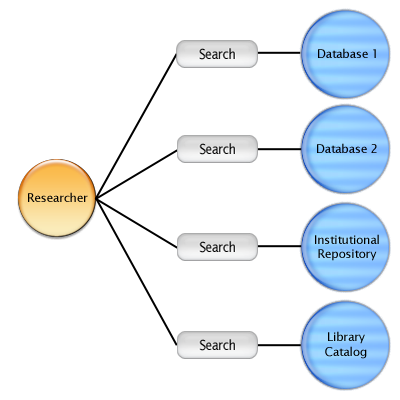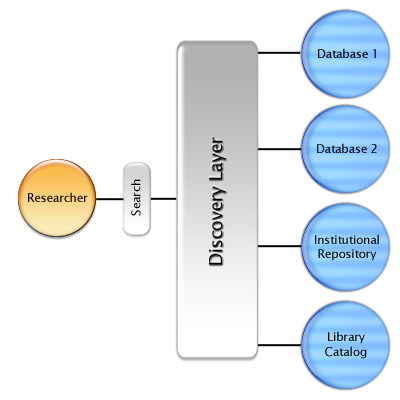What is Discovery
Libraries, over the past few years, have been moving away from traditional search mechanisms that require researchers to consult separate interfaces or applications depending upon the type of material they’re looking for. For example, if you wanted a journal article, you might search an article database like JSTOR or consult a periodical index; if you wanted a book, you might search the library catalog ; finding newspaper articles might require another type of database, like LexisNexis; to locate a dissertation, you’d need eScholarShare or an abstract index …well, you get the idea.
This traditional, multi-search, multi-interface model is being replaced by a single search interface, a discovery interface, where results from many different types of sources (including those mentioned above) are gathered and stored in a central index. Cowles Library implemented SuperSearch as our discovery interface in August 2010. The different approaches are illustrated below:
Discovery as Finding
Whether the interface is referred to as a discovery tool, discovery layer, or discovery service, its purpose is the same: to harvest relevant results from a variety of different sources and display them to the researcher in a useful way. Research methods and search strategies remain an essential part of the discovery process, but as the illustrations above show, discovery reduces the number of targets at which researchers must aim their search. If well-executed, discovery allows a researcher to spend more time evaluating material and less time hunting for it.
Discovery as Revelation
One of the goals of discovery as a concept is to introduce a measure of serendipity to the research process. Providing a researcher with results from many different sources increases the chance that she will encounter something she hadn’t considered before. For beginning researchers in particular, who may not be aware of which databases, journals or repositories are most appropriate for their topic, discovery can be incredibly helpful.
Discovery as Exploration
Another element of discovery incorporates resources from outside the library’s current collection. These resources may take the form of on-demand titles that the library does not own but can purchase and make available, either immediately (in the case of e-books) or in a very short time (in the case of journal articles or print books). Another example might be an article index that doesn’t contain full text, but because the discovery service can map a citation to one of the library’s full text sources, it can lead researchers to the full text. Web of Science is an example of such an index.
Keep in mind that discovery is not intended to be a one-size-fits-all search solution (nor, for that matter, is any search method). There are, and likely will always be, discipline-specific databases whose search functions will not be replicated in discovery (if you are researching in health sciences, for example, you’ll want to become adept at searching PubMed). Instead, think of discovery as one of many tools that belongs in your research toolbox.




